Brazil? Who would want to go ride a motorcycle in Brazil?
Myself, for one, though with no real idea of where we would be going. The worldfamous beaches of Rio de Janeiro would be on the itinerary, of course, but other than that, where would Brazilian roads lead me?
That is the fun of one of these Edelweiss “scouting tours”—not really knowing what to expect. When halfway through the tour we got to Ouro Preto (Black Gold), I was completely entranced; here was a place I had never heard about, a 300-year-old city tucked away in the mountains, with 21 churches sitting on the hilltops, steep cobblestone streets leading every which way. That alone, for me, was worth the price of admission to this tour.
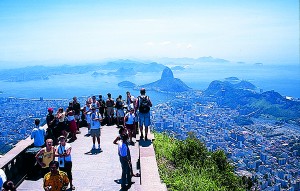
Ten experienced motorcyclists arrived at the São Paulo airport to take part in this trip—six Germans, four Americans. I should note that these 10 participants had, collectively, over 60 Edelweiss tours under the seats of their riding pants, which meant that they knew a bit of geography.
Our leader was the indomitable Austrian, Werner Wachter, who has made Edelweiss Bike Travel the most successful motorcycle touring company in the world. Now he wants to extend his geographic repertoire to Brazil, which is larger than our 48 contiguous states, with a population approaching 180 million. What is the make-up of a good motorcycle tour? A number of essential parts include: The country has to be interesting. The roads have to be fun to ride. The accommodations must be pleasing. The food should be tasty.
Ah, the food! Touring should include pleasant gastronomical experiences, and I admit that I ate so well, and so consistently, that I never once felt hungry while on the tour. The Brazilian staples are rice and beans and bread, accompanied by large amounts of savory cooked beef, pork, poultry and seafood. Occasionally we ate at rather chi-chi restaurants, where quality was good but presentation was more important than quantity; mostly we enjoyed excellent trencherman fare.
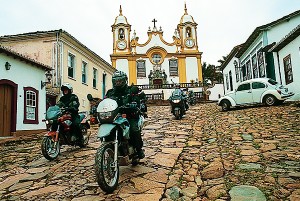
The lunch I had at a roadhouse called, curiously, Charmin Country, was so good I could have eaten there for the entire trip. It was a buffet, with a dozen cast-iron pots full of delicious stews and simmering meats, another table with all manner of salad fixings, and a row of desserts—as much as you could eat for 10 reales, less than $3.
Brazil is by far the biggest country in South America, and should be the dominant force in that continent, although it can’t really seem to get its economic transmission out of second gear. Here is the thumbnail history: The place was sparsely populated by Indians when a Portuguese ship arrived in 1500. For the next 300 years relatively few Europeans immigrated here, mostly to search for precious metals. In 1822 an ungrateful son of the Portuguese king declared the colony independent and crowned himself Emperor Pedro. His own son, Pedro II, was deposed peaceably in 1889, and the United States of Brazil, with 26 states, was created.
The Amazon River basin makes up the northern half of the country, the southern half being more amenable to ranching, agriculture and mining. Our 11-night, 1,500-mile tour would stay in the south, starting at the Tropic of Capricorn and making a big loop northeast along the coast to Rio, north toward Belo Horizonte, west to Araxa and south back to São Paulo.
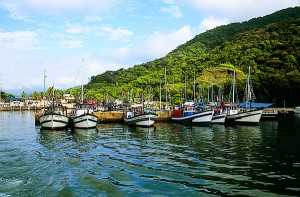
Leaving São Paulo (no easy feat, considering that the 16 million people who call the place home all seemed to be on the road at the same time), we headed down to the coast. Where the road, mostly two-lane, swept along the shore graciously, clean white beaches to the right, thick tropical vegetation to the left. Leading us was Arturo, a Brazilian journalist and motorcyclist, and following was van-driving Carlos, co-owner of Melbourne Tours, a São Paulo travel agency that has long been sending Brazilians on Edelweiss tours in other countries. All told we had nine motorcycles, three with passengers.
The first night was in Ubatuba, a great name for a small resort about halfway between São Paulo and Rio. We stayed in a wonderful small hotel, about 20 rooms, right on the beach. Dinner was on the patio, and the broiled seafood was excellent.
In the morning we had a brief diversion, taking a boat out to Anchieta Island which used to house political prisoners; it is a lot more friendly than Alcatraz, I promise you, with a lot better climate. Then it was off to Rio. As became the habit for most of the trip, our group broke into two, Werner leading one, Arturo the other.
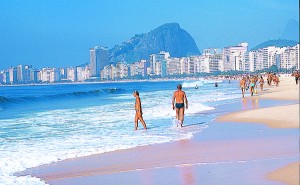
We stayed for two nights at Le Meridien, a multistar, 37-floor hotel right on Copacabana beach; one could not ask for better. On our off day, the temperature being very hot and humid, we saw the sights using Carlos’ air-conditioned Mercedes van. Taking the steep funicular tram up to the huge statue of Jesus the Redemptor on top of the 2,000-foot hill called Corcovado, we were delighted by the spectacular views of the city and the Bay of Guanabara. In the afternoon we used an aerial tram to get to the top of Pao de Acucar (or Mount Sugar Loaf, as it looks like a mound of processed sugar), which oversees the narrow opening to the huge bay, the best natural port on the 4,600 miles of Brazilian coastline.
Late that afternoon Werner and I walked across the boulevard in front of the hotel to the beach and went for a swim. I had left my money locked in the safe in my room, as is appropriate, and had the key in the pocket of my trunks. The use of the safe was gratis, but I had signed a small piece of paper saying that if I lost the one-of-a-kind key, and the hotel had to drill the lock out, it would cost me $80. Guess what? I got rolled in the surf, lost the key, and spent $80 for the pleasure of a swim. One learns.
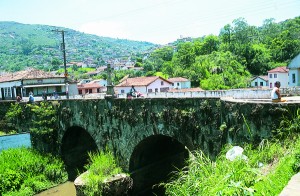
Next day we rode north into the mountains that separate the coastal plain from the inland plateau. After a good twisty climb through the National Park of the Dos Orgaos Mountains, we arrived at the 19th-century city of Petropolis, which was the summer home of the Emperor Peter II—hence the name. His palace is now a museum, with magnificent wood floors, and all visitors are required to wear soft slippers that fit over shoes and boots; this serves a dual purpose, both protecting the wood and keeping it shiny.
A day later, following the old Royal Road, a curvaceous stretch of new two-lane pavement from which trucks are banned, we arrived in Ouro Preto, which was home to 120,000 inhabitants back when New York City had only 40,000. Our crew was housed in the 18th-century building that was once headquarters to the region’s administrator, and is now an elegant pousada (inn). We had a free day there, and I could easily have used three or four days to soak up the history and the atmosphere. And contemplating the purchase of semi-precious stones.
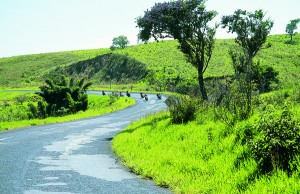
Leaving here our scouting ride took a different route from what the normal Brazilian Edelweiss tour would follow. The future itinerary will stay closer to the coast and in the mountains, on curvier roads, while we were headed off to Araxa, 300 miles west of Ouro Preto in the middle of a great plateau. Most of the road was quite straight and lightly trafficked, with the stretch west of the town of Luz being sportbike heaven, 75 blissful miles of fast sweepers. It was along here that we found the only gas station which did not have gas—although the attendant said there was a place 15 miles down the road where we could replenish the tanks. Truth.
At Araxa we stayed for two nights at the truly glorious Grand Hotel & Baths—along with some 300 members of the Brazilian BMW club at their annual national gathering. The five-story hotel was completed in 1944, in the grand style, with huge banquet rooms and corridors a hundred yards long; I wanted a bowling ball to scoot down the carpeted halls. At one end of the hotel were the hot springs and baths, with treatments in both “sulfuricated” and “radioactive” waters, depending on what ailed you.
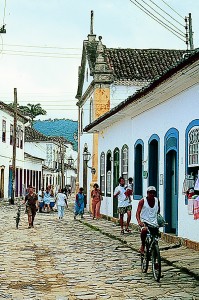
From Araxa we headed south across rolling plateau, and the Rio Grande, to Ribeirao Preto—half this ride was fun, the second half a bit boring as we found ourselves on a major highway, and more entertaining secondary roads seemed to be lacking in this sparsely populated part of the country. Perhaps this was payback for our detour to Araxa and the pleasure of hobnobbing with the BMW crowd.
The last day was definitely a bore, as there was nothing but divided highway between R.P. and São Paulo. Which city, I believe, is the largest in the Western Hemisphere…but our indomitable guide, Arturo, managed to get us all safely back to the Hilton Hotel.
Had we come down the road that promises to be on the regular tour, on the day before São Paulo we would have ended up in Campo de Jordao, known locally as Little Switzerland, on the Serra de Mantiqueira, which is just a couple of hours from S.P. But all of us scouts knew beforehand that we were going to do the Araxa thing, so nobody complained.
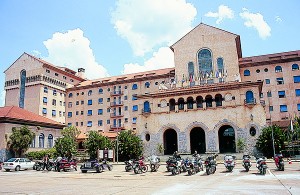
My opinion of the tour? The first half was great, while the Araxa deviation caused us to have some pretty dull riding on the last two days. Presuming the Edelweiss route to be followed on regular tours will make the second half as entertaining, I recommend the trip. This certainly will not be as popular as the Alps or New Zealand, but anybody looking for a great ride, excellent food and good accommodations, in an interesting place, should love this one.
Also, it provides great one-upmanship. “Gee, Clement, I haven’t seen you in a couple of weeks. Where’ve you been?”
“Oh, Brazil.”
Nozes e Pinos (Nuts and Bolts)
What you get for your money.
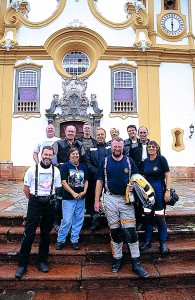
Edelweiss is constantly expanding its geographic horizons, and Brazil is just the latest. Cost for this trip varies, from sharing a room and riding wo-up on a BMW F650 for $2,650, to a single room and an R1150RT for $5,480. Add to that the airfare from the United States, which will probably run around $800.
Once you arrive at the São Paulo airport, all transfers, hotels, breakfasts and dinners are taken care of. You pay for lunches and gas; food is inexpensive and good, gas runs about $2 a gallon. Add to that libations, such as a bottle of water or wine with dinner.
Hotels range from luxurious high-rises to more modest establishments, depending on our whereabouts, but always clean, with gracious service, and lots of hot water. I drank tap water in all the hotels, and suffered not.
Werner recommends a proper riding suit; since you are in the tropics, make sure it is well-ventilated. The coast is hot and humid, inland is usually warm; we had only one afternoon of rain, which means Werner had propitiated the weather gods.
Werner has two more “scouting tours” planned for Brazil in April 2003, which will be used to determine the final itinerary. For more information call the U.S. contact, Tri-Community Travel, at (800) 507-4459, or run up www.edelweissbike.com on the computer.







